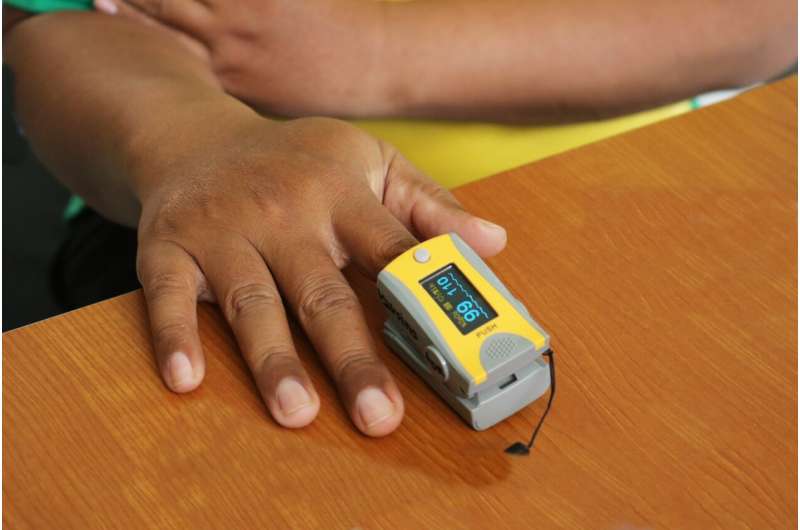This article has been reviewed according to Science X's editorial process and policies. Editors have highlighted the following attributes while ensuring the content's credibility:
fact-checked
peer-reviewed publication
trusted source
proofread
Study demonstrates how pulse oximeters significantly overestimate readings in people with darker skin tones

Pulse oximeters—one of the most common medical devices used in global health care—can provide significantly overestimated oxygen saturation readings in people with darker skin tones, according to the most comprehensive study ever to explore the issue.
Published in the British Journal of Anaesthesia, the new study is based on a systematic review of previous research into the use of the devices, and examined 44 studies dating from the mid-1970s to the present day.
In the course of that, researchers assessed more than 733,000 oxygen saturation readings taken from over 222,000 people—including almost 70,000 people of non-white ethnicity.
They found most of the studies revealed evidence of the devices being inclined to overestimate readings in participants with darker skin tones.
While the researchers say it is challenging—based on the current available data—to state the magnitude of those overestimates, they insist it could create a number of issues for both patients and medical professionals.
It could, for example, result in patients not being able to see a doctor as—based on the readings generated by the pulse oximeter—they are deemed to be healthy.
And with studies suggesting the errors are exacerbated at lower levels of oxygen saturation, it could result in patients with critical oxygen levels not receiving treatment that they urgently need.
The new study involved experts in intensive care medicine, dermatology and pediatric care from a number of leading universities and hospitals around the UK.
Professor Daniel Martin OBE, Professor of Perioperative and Intensive Care Medicine in the University of Plymouth and a consultant at the University Hospitals Plymouth NHS Trust (UHP), is the study's lead author.
He said, "As clinicians, we rely on accurate data to make informed clinical decisions. But during the COVID pandemic, and to some extent since, it was necessary to put thresholds in place which meant that people were only admitted to hospital if their levels fell to a certain point. If those levels are being overestimated—so, for example, if a device is telling someone their oxygen saturation is 98% whereas it is in fact significantly lower—it could realistically mean people are missing out on treatments they need."
When pulse oximeters were introduced around 50 years ago, they were intended solely for use in hospitals and a handful of other health care settings.
Today, they are used in everything from GP surgeries to outpatient departments, emergency rooms and intensive care units all over the world, where they are used to monitor the health of people with virtually every form of medical condition.
Crucially, they are also available for the public to purchase in shops, pharmacies and online and many are encouraged to take regular measurements of their oxygen saturation levels in the course of managing a range of health conditions.
Professor Martin said, "If people are admitted to hospital, there are other safety mechanisms to help identify unwell patients. Blood tests to measure oxygen levels, for example, will not be impacted in any way by a person's skin tone and a medical appointment will allow a doctor or nurse to carry out a physical assessment as well as other types of monitoring. The concern is that there may be people in the community relying on pulse oximeter readings to signify a deterioration in their health, where these additional tests are unavailable."
Study co-author Professor Eugene Healy, Professor of Dermatology at the University of Southampton and honorary consultant in University Hospital Southampton NHS Foundation Trust, said, "This systematic review highlights the need for clinicians to take account of a person's skin tone as part of the clinical decision-making process when using pulse oximeters to estimate oxygen levels."
The findings revealed through the systematic review are already being explored in much greater detail through the EXAKT study, also led by Professor Martin.
It is currently in the process of recruiting around 900 critically-ill patients with different skin tones from 24 sites around the UK to investigate the accuracy of specific pulse oximeters used in hospitals across the UK today.
More information: Daniel Martin et al, Effect of skin tone on the accuracy of the estimation of arterial oxygen saturation by pulse oximetry: a systematic review, British Journal of Anaesthesia (2024). DOI: 10.1016/j.bja.2024.01.023



















